Maybe the most noticeable feeling in Apple’s latest product unveiling – that sense that a Mac notebook launch brings real excitement again. “I sense something. A presence I’ve not felt since…”
This is available to order now and ship next week, so I think some of your credit cards beat me to even writing this story. Notably, everything about the M1 Pro and Max – plus that roomier MacBook Pro form factor and all those ports – indeed seem worth the wait. This is a new generation of advanced CPU/GPU/machine learning architecture with fast memory and storage, coupled with a top-flight display and Apple’s distinctive hardware design.
And so, yes, the MacBook Pro line is also bringing back the stuff you missed. Those who stayed with PC machines will laugh at this, but that means real function keys, no more weird touch strips, a dedicated HDMI port (without dongles, even), and tons of ports. Plus there’s a MagSafe port again for power.
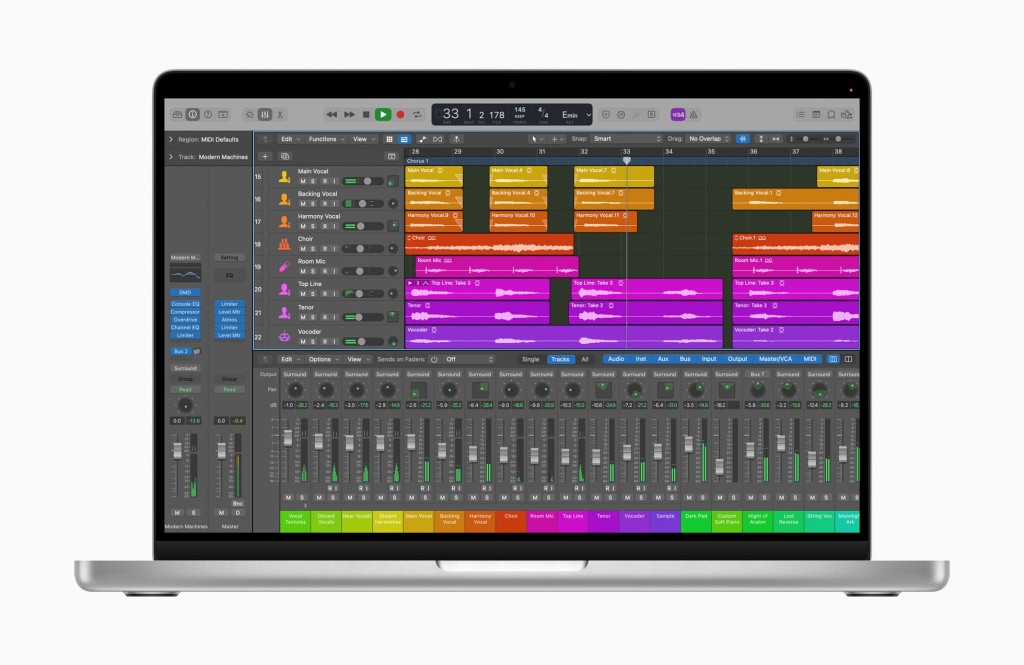
But that’s not what’s giving me a sense of deja vu. The real throwback is we got to see a Mac event that emphasizes music production alongside visual eye candy magic, puts Logic front and center (there was even a cameo by Soma Laboratory in the opening so someone got a fun way of spending their budget). And you got the sense of a radical new laptop that put desktop power in a mobile form factor, while conserving a slim case, elegant industrial design, and managing both battery life and quiet operation without sacrificing horsepower.
It’s definitely 2021 Apple – just specs, product front and center, testimonials only briefly from developers but not users. (no BT!) But no matter – it really does feel like an unofficial 20th anniversary of this moment:
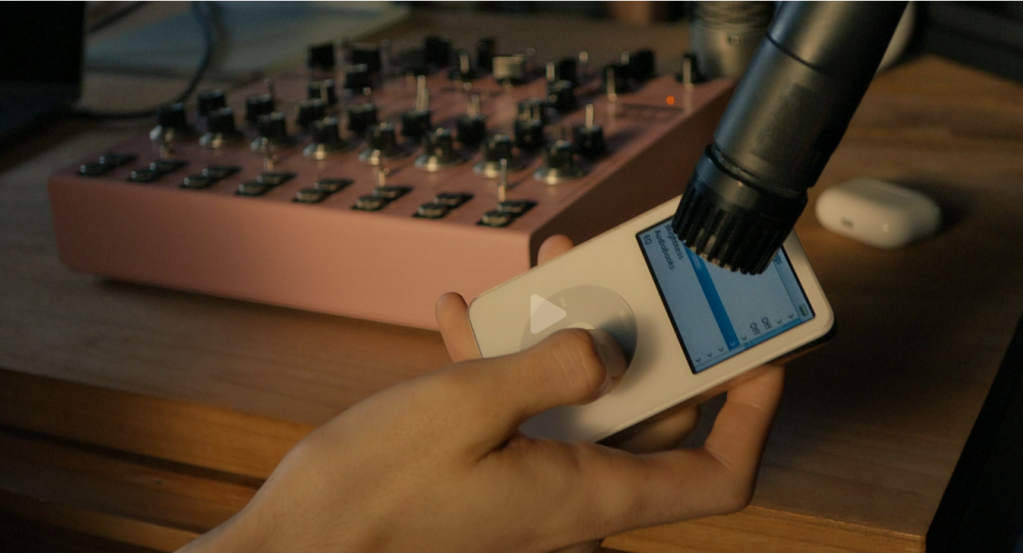
Also on the cultural front, Apple had the sense to commission Berlin-based artist Gabriel Massan to do those splendid visuals. Check their work:
And now, as then, Apple is really good and cutting past the specs and just speaking directly in a way that gets to what people want.
Of course – I don’t work for Apple marketing, so my job is to get back to those specs, and past that, how this will work in practice for creative folks. (And to the extent I can’t do that, which is – well, a reality – it’s my job to find the folks who can get those answers.)
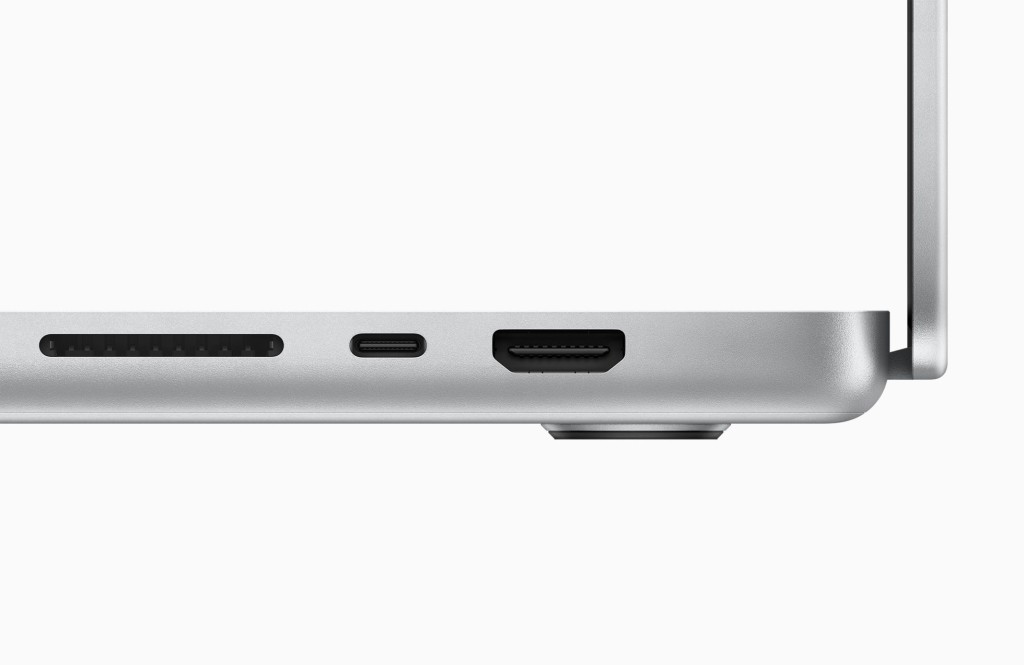
It’s too soon for that, but we do see some promising numbers here. One thing I do miss from 2001 Apple (and Jobs, absolutely) is comparisons to PCs. Not that we should trust Apple to give us a (cough) unbiased view of that, but I do think the absence of one-on-one comparisons to something like NVIDIA RTX-based systems is a little telling by design. There was a brief graph in the presentation of PCs with dedicated GPUs which was stunning except… well, the graph had no numbers and I have no idea what GPU that was because the print was too small. (See, there’s the Apple we know and love!)
What are they comparing?
Updated – reading the fine print on the PC vs Mac graphs.
So there’s a CPU test, with the high-end, 8-core machine an MSI GP66 Leopard.
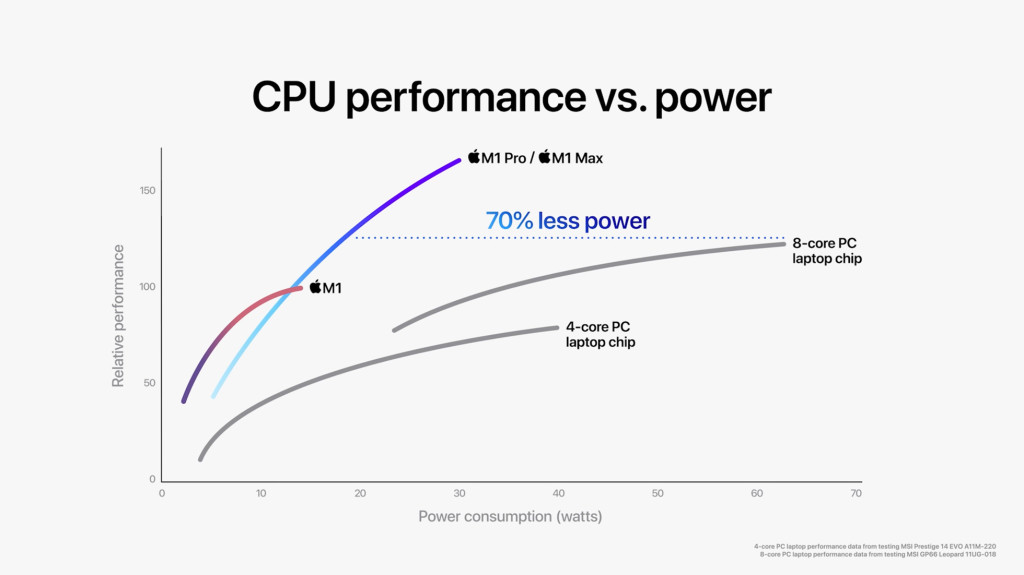
That’s as expected, really – Apple’s architectures are delivering more performance for the same power consumption (and by extension, heat generation).
Note that the GP66 is significantly cheaper when similarly configured with memory/storage, but yeah, you’ll probably hear a fan and I don’t think you’ll get anywhere near the hours of battery life on the Apple machine. (Plus Apple is shipping high-end machines that charge via USB-C ports. That MSI will require a dedicated 280W power adapter.)
“Relative performance” is – relative to what? Of what? Just… what does that axis even mean? I’ll try to find out.
It’s really the graphics comparison where I’m interested. You’ll see an even higher-end MSI and Razer machine in comparison, too – check the newsroom to dig in.
Here we also find out that the Apple machines produce more performance per power consumption than does an NVIDIA RTX-based GPU. The problem is, we don’t know what the relative performance actually represents, so it’s not really as earthshaking as it may first appear – think of this more as a teaser for why benchmarking this gets interesting than it is something you would use to make a purchase decision. (Whee! Lines! Get my wallet!)
But don’t get me wrong – it is still promising where this is heading.
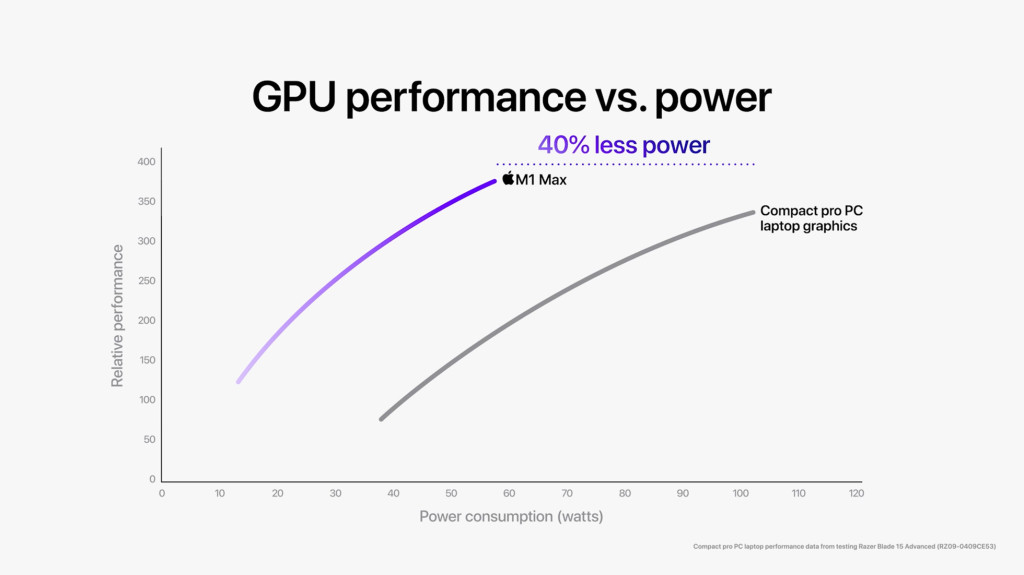
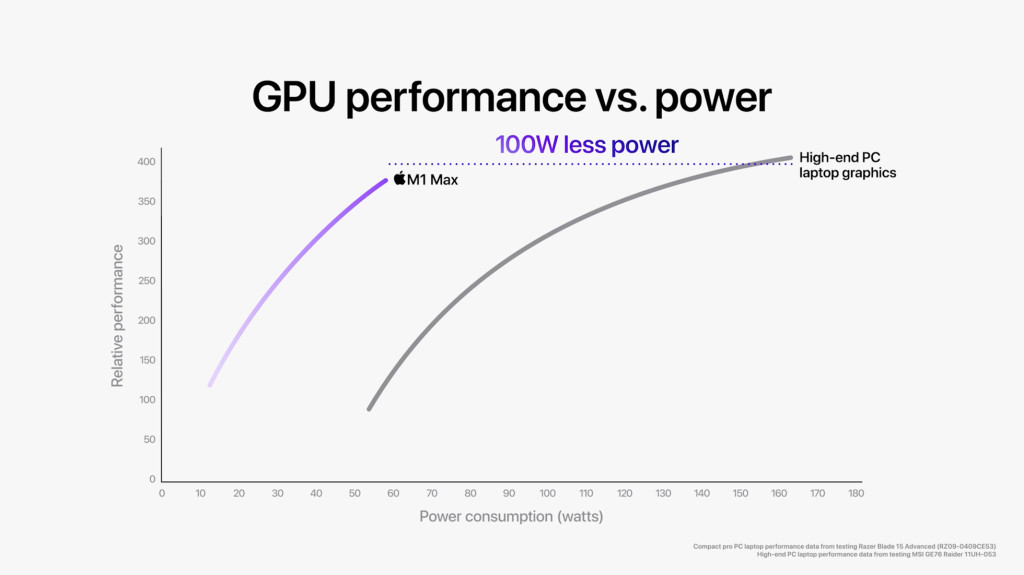
It will be cool, somehow, but we have to find out how.
Probably as interesting is what Apple chooses for comparison. They’re positioning the M1 Max against the MSI GE76 (RTX 3080) and Razer Blade 15 Advanced (RTX 3070).
Let’s talk specs and upgrades
There are some specs that do jump out immediately, though, especially some that really have no fair PC architecture comparison at the moment. And we are back almost in vintage Apple, too, in that we have an Intel (or AMD derivative) architecture on one side, and Apple’s own architecture on the other (now even more proprietary, since they’re making the chips). I do love a good horse race, so this has my computer nerd sense tingling.
Some of the specs we do know:
The new Macs do unified memory – for both CPU and GPU. As Apple (fairly and correctly) points out, this means you can max out Macs at 64 GB of memory that’s accessible from both the graphics and computational subsystems. On a traditional architecture, you need separate video RAM, which right now on the PC is limited to 16 GB (for the time being). The flipside is true, which is if you do intend on using all that memory for graphics, you’re subtracting from what’s available to the CPU, but having one pot for everything is generally an edge.
You get a ton of computational power. Yeah, this pretty much hoses the Intel i9 that was in the previous models, it looks very competitive with what’s on the PC from Intel and AMD, and you get that power without a fan so much as switching on. More battery life, no fan noise, less heat, crazy amount of power. 8- or 10-core CPU, plus a Media engine doing even more acceleration of video encode/decode.
Machine learning power is a real thing now, too. Look, let’s forget the AI hype – machine learning is in many ways a graphics-related technology, and there it shines. So this new machine is fast at scene edit detection, object tracking, and subject selection in Premiere, Final Cut, and Photoshop, respectively – by several orders of magnitude, according to Apple. This is not “AI replacing humans” so much as “AI making computer graphics magically quick the way we always wanted.”
There’s a powerful GPU, too. For graphics, you now get 14- or 16-core GPUs. It’s still too soon to say how this stacks up against high-end GPUs on the PC – like the kind that presumably were even running the presentation everyone saw – but I imagine for a lot of video and visual applications, combined with all that video memory, this will be competitive. And while desktop PCs will continue to dominate high-end graphics and gaming, the industrial design and quiet, mobility, and battery life on the Mac tilt things in Apple’s favor before any comparisons. I do want more comparisons here though, to know the details.
You can use multiple displays again. Finally. 2 external displays on M1 Pro; 4 on M1 Max.
It’s still not cheap with storage and RAM. Apple has put insanely fast SSDs in these machines again – they’re talking 7.5G/s transfer speeds. The unified memory is speedy, too. So you can’t really compare spec-for-spec. But with these high-end, premium components comes at a price as you add memory and storage, which you’ll want to do right away, of course, since they’re not upgradeable later. Taking the most basic 14″ MacBook Pro, I’m quickly up to US$2599 with 32GB unified memory and 1TB SSD. That’s the other reason we will want some real head-to-head comparisons with the PC architectures.
But all in all, the specs look great. And now that they have gotten rid of the stuff you didn’t like – the weird redesigned keyboard, the mostly-panned Touch Bar – and added back function keys and a new keyboard and lots of dedicated ports, this is likely to get back to being the world’s most loved notebook machine.
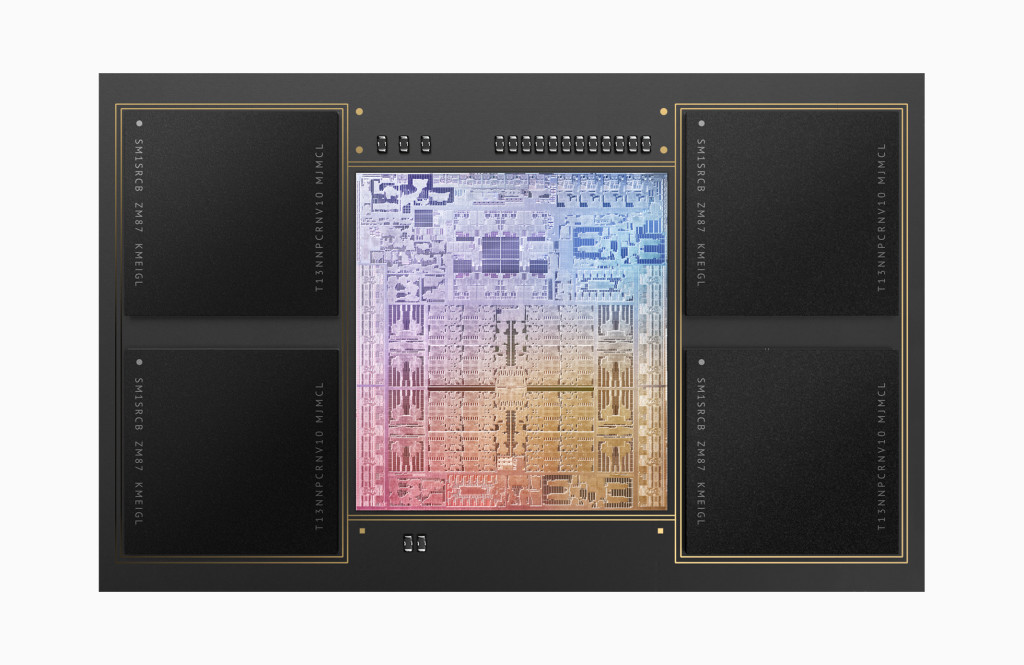
Plus, Apple’s industrial design and high-end displays are generally not matched by anyone else, to say nothing of that OS from Apple.
And yeah, Apple has trade-in and financing programs, too, which is not irrelevant.
Readers of this site know I do love computers. I’m excited to see fresh stuff happening on both PCs and Macs and software across the board, musical and visual. There’s tremendous expressive power even on a relatively small budget in just one machine, which is great for independent artists. Watch this space for more details.
Let me know if you have some questions as we learn more.
Other specs I think are worth handling (the full specs you can read at Apple.com, so I’ll edit here):
200GB/s memory bandwidth (on the Pro – double that to 400 GB/s on the MAX)
Really nice displays (let’s leave it at that – but think 120 Hz, big color gamut, microLED, 3024×1964, that sort of thing)
USB-C to MagSafe 3 power connection (so you get the magnetic connector back if you want it but do note that you can also charge off any of the USB-C ports… in case you don’t have that pricey connector cable)
512GB minimum storage (finally), up to 8 TB
HDMI port
Dedicated SDXC card slot
3.5mm headphone jack
Three Thunderbolt 4 (USB-C) ports – all of them fully capable for everything, basically
https://www.apple.com/macbook-pro-14-and-16/specs/